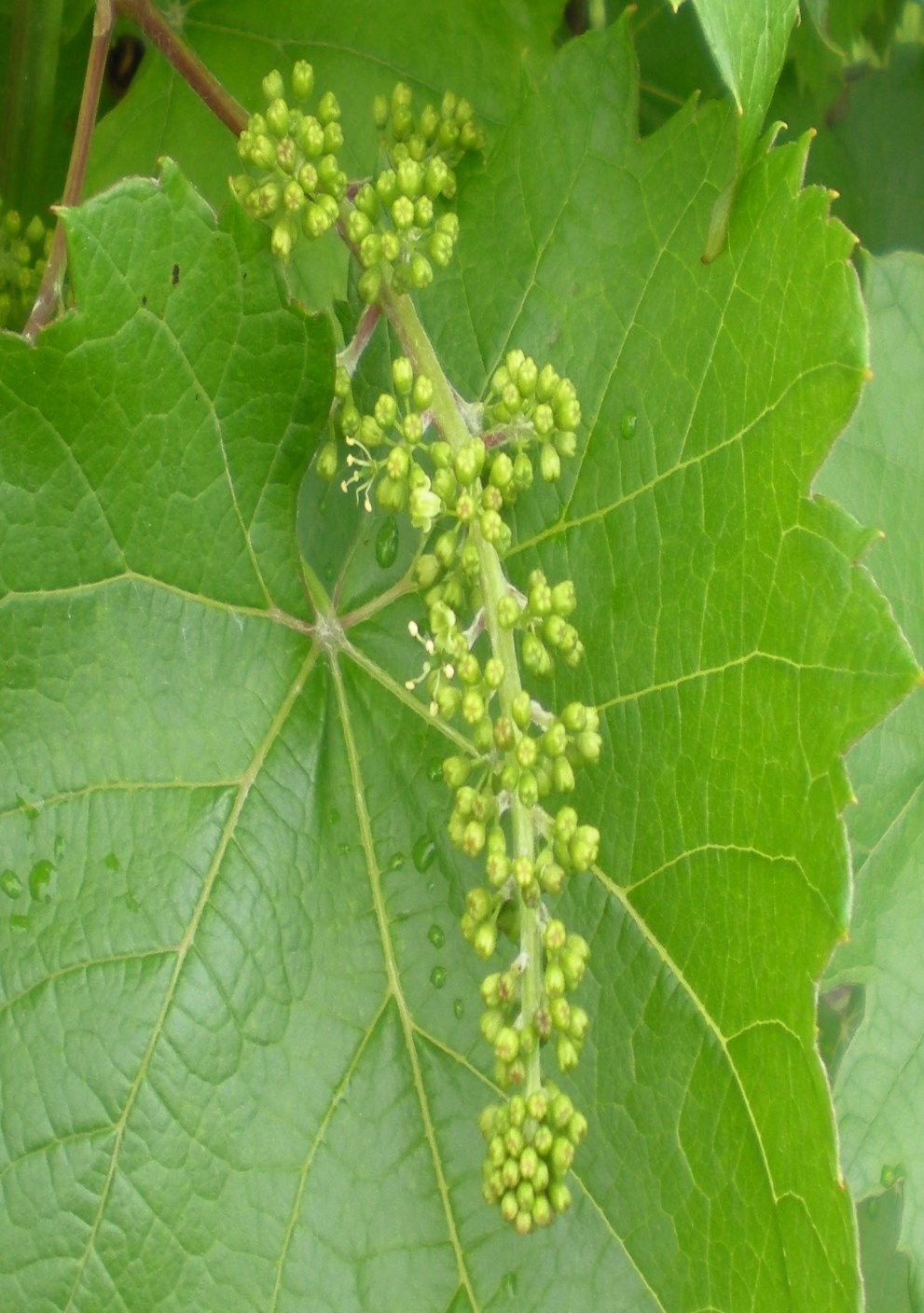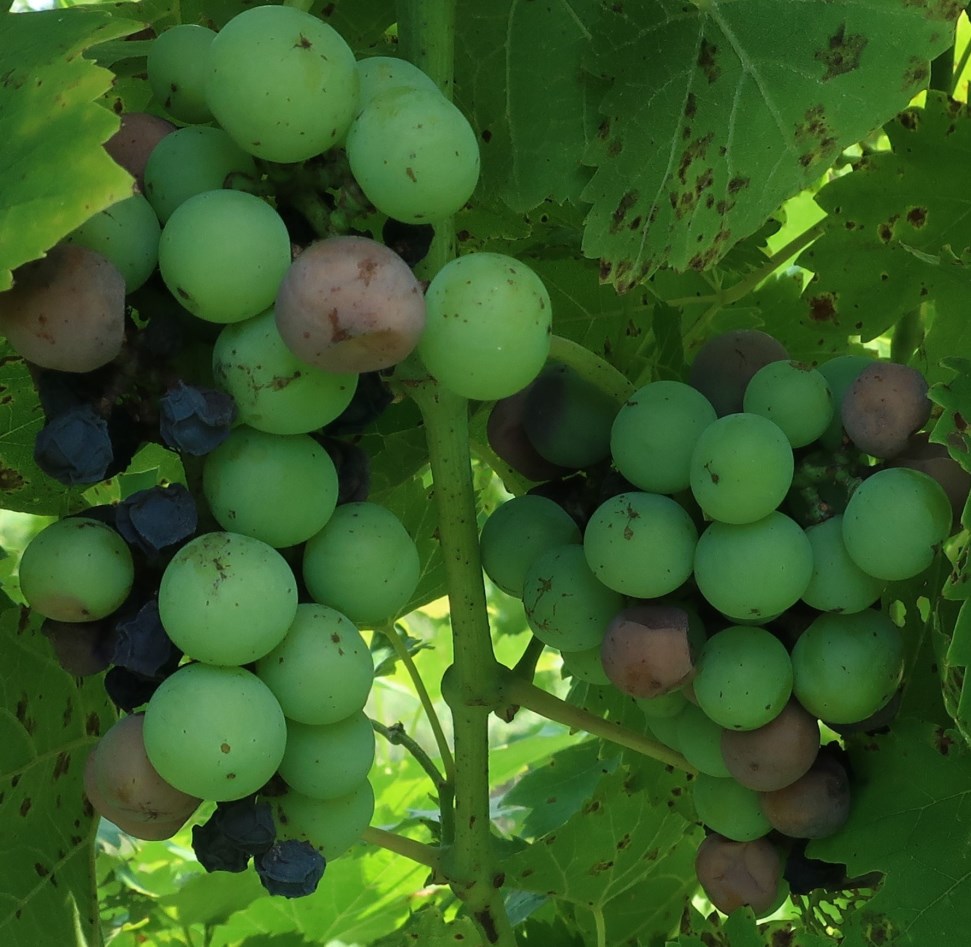Vinews
No. 5 — May 23, 2022
Contents:
Crucial Period of Disease Management

As the florets on the inflorescence begin to separate this is a visual cue that the grapevines are entering the critical period of disease management (Figure 1). The period of time from immediate pre-bloom to five weeks post-bloom is when disease pathogens can cause catastrophic damage. A number of pathogens can infect a grape crop during this critical period. Some of these pathogens could be coined invisible invaders since the damage from an infection at bloom will not appear for a long period of time. Both Phomopsis cane and leaf blight, Phomopsis viticola and bittter rot Greenaria uvicola can infect at bloom with delayed symptom development. After infection at bloom these two pathogens become quiescent and as the fruit enters veraison the pathogens are awakened. Once symptoms are apparent on the fruit, future disease management is to reduce the spread. In the case of Phomopsis infection at bloom there is no secondary spread as grape berries will shatter and fall to the ground. In contrast, bitter rot infection at bloom will result in infected berries producing secondary spread. In addition, to Phomopsis viticola and Greenaria uvicola the more common pathogens all remain a threat during the critical period.
Without question, black rot, Guignardia bidwelli and downy mildew, Plasmopara viticola are far and above grave threats during the critical period. This is not new news and was known as far back as 1883 in Missouri. Back then when grape growers spoke of early June with heavy thunderstorms and morning dew their focus on black rot was summed up as:
“We may look and wonder, powerless yet knowing”
“That the bright hopes of to-day
May be dispelled by the next morn”
— Bushberg Catalog 1883, page 50, Jefferson, MO

Photo credit: D.S. Volenberg. Quote credit: Bushberg Catalog 1883, page 50, Jefferson, MO
Fortunately, today we have management tools to help protect the crop from these insidious diseases. They key word in the last sentence is “protect,” meaning the management needs to be applied prior to infection. I believe some of us can relate to being ....”dispelled by the next morn.” The grape crop looks perfect one day but by the next day, black rot has ravaged the fruit (Figure 2).
Right now we are entering the period where attention to detail will pay dividends at harvest. The immediate pre-bloom to 5 weeks post-bloom is when you should consider using your best disease management tools to control the grape disease complex.
Select fungicide products that will provide protection from Phomopsis, black rot, downy mildew, powdery mildew, and anthracnose. These are the five major diseases of concern. Take some time now to plan for your next three cover sprays. This will help to avoid applying the same products repeatedly, which can result in the selection for fungicide resistant pathogens. Depending on your past disease problems from last season as well as disease outbreaks that may have occurred this season consider using both systemic fungicides as well as protectant fungicides in a tank mix to protect your crop.
Phomopsis remains a threat, especially during the bloom period. During bloom, Phomopsis spores can infect developing flowers. Phomopsis development remains dormant in developing berries until brix levels begin to rise starting at approximately 15 brix. Infected berries begin the rotting process and some infected berries shatter. The primary inoculum of Phomopsis is depleted shortly after bloom. Although grape berries are susceptible to Phomopsis throughout the growing season, reduced primary inoculum coupled with increasing temperature conditions reduce the threat of Phomopsis infections after the bloom period.
Use The Best Fungicides To Protect The Crop During The Critical Period: Avoid Repeat Applications Of The Same Fungicide And Fungicides From The Same Chemical Class
During the critical period (pre-bloom to five weeks post-bloom), fungicides from two chemical classes are often applied. Fungicides from these two classes provide good protection to a broad spectrum of pathogens. The two classes of fungicides are the strobilurins and the sterol-inhibitors. Both powdery mildew (Michigan) and downy mildew (Virginia, North Carolina) have been identified that are resistant to these two classes of fungicides Therefore when planning your critical period spray program implement a spray program that avoids sequential applications of the same product or products within the same chemical class. Many of the labels of both strobilurins (Frac 11: Abound, Sovran, Flint Extra) and sterol-inhibitors (Frac 3: Mettle, Procure, Rally or TebuStar) limits the number of applications during the growing season. For example, the Rally label states that only two sequential applications of Rally or Rally and another product containing the same active ingredient as Rally or another Sterol inhibitor can be applied. Fungicides that contain more than one active ingredient (Pristine, Inspire Super, Revus Top, or Quadris Top) are also effective for broad spectrum disease management.
As the grape berries age, they become resistant to some fungal diseases. Grape berries develop resistance to black rot, downy mildew, and powdery mildew approximately three to five weeks after bloom. Therefore, early season disease management through post-bloom disease management are critical. Although berries develop resistance, other green tissue remains susceptible throughout the growing season.
topWith Bloom Approaching, Remember Petiole Sampling

Grape growers that have vineyards just coming into fruit production often have questions about vineyard nutrient management. The questions often have to do with when and why they should monitor the nutrient status of the vines. Tissue analyses of petiole samples is normally undertaken for two reasons; routine nutrient status evaluation and to diagnose an observed suspected nutrient deficiency.
The routine assessment of the vines nutritional status should be done at a specific phenological stage. These phenological stages are full flowering or veraison. Full flowering can be defined as when 50% of the caps are shed on 50% of the inflorescences, whereas veraison is the onset of rapid fruit maturation, where visually a distinct color change is occurring. This color change is obviously more distinct in red varietals than white varietals. In white varietals, the color change often is from a dull green to a lighter transparent yellow.
The routine assessment of the vines nutritional status should be done at a specific phenological stage. These phenological stages are full flowering or veraison. Full flowering can be defined as when 50% of the caps are shed on 50% of the inflorescences, whereas veraison is the onset of rapid fruit maturation, where visually a distinct color change is occurring. This color change is obviously more distinct in red varietals than white varietals. In white varietals, the color change often is from a dull green to a lighter transparent yellow.
The goal of routine nutrient assessment is to gauge the response of the vines to nutrient additions or determine the vine's nutrient needs. The overall objective is to maintain the nutrient balance to produce high quality grapes by applying only nutrients that are needed, thereby saving money and also protecting the environment.
Petioles are collected from different locations on the shoot depending on the sampling period — full flowering or veraison. At full flowering you select leaves that are opposite of the flower clusters. Whereas at veraison, the sixth or seventh leaf from the shoot tip, which is the most recently fully expanded mature leaf is selected. Avoid collecting leaves from laterals. Once a leaf is collected, break the petiole (leaf stem) away from the leaf blade and discard the leaf blade. You will need to collect 60 to 100 petioles for a sample. These petioles should come from 25 to 50 different vines, but be of the same variety, rootstock, and soil type. If your vineyard has variable soil types, divide your vineyard into blocks and petiole sample each block.
In the case of trying to diagnose a suspected nutrient imbalance in a vine(s), you may only be able to select leaf samples from one or a few vines. Select leaves that are showing the suspected deficiency, but do not collect petioles from leaves that are insect, disease, or mechanically damaged. In addition to this sample, also collect petioles from the same variety that is not showing the deficiency. Send in both samples to be analyzed. You will then have results to compare from a healthy vine(s) and those vine(s) showing a deficiency.
Petioles should be stored in a paper bag to allow the petioles to dry. Petiole samples can be dropped off at University of Missouri County Extension Centers and will be analyzed by the University of Missouri Soil Testing and Plant Diagnostics Services.
topPlease scout your vineyards on a regularly scheduled basis in an effort to manage problem pests. This report contains information on scouting reports from specific locations and may not reflect pest problems in your vineyard. If you would like more information on IPM in grapes, please contact Dean Volenberg at 573-882-0476 or 573-473-0374 (mobile) or volenbergd@missouri.edu